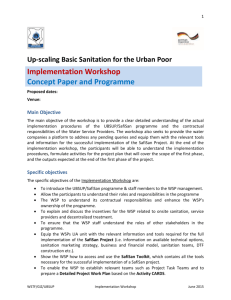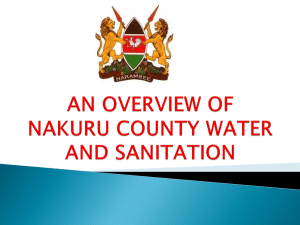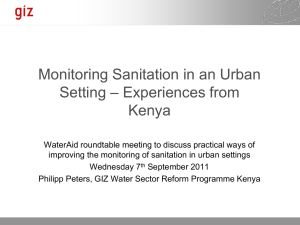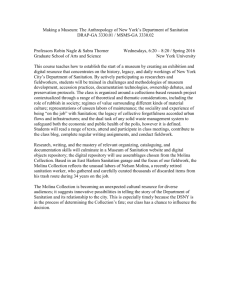2. NAWASSCO Induction Report
advertisement
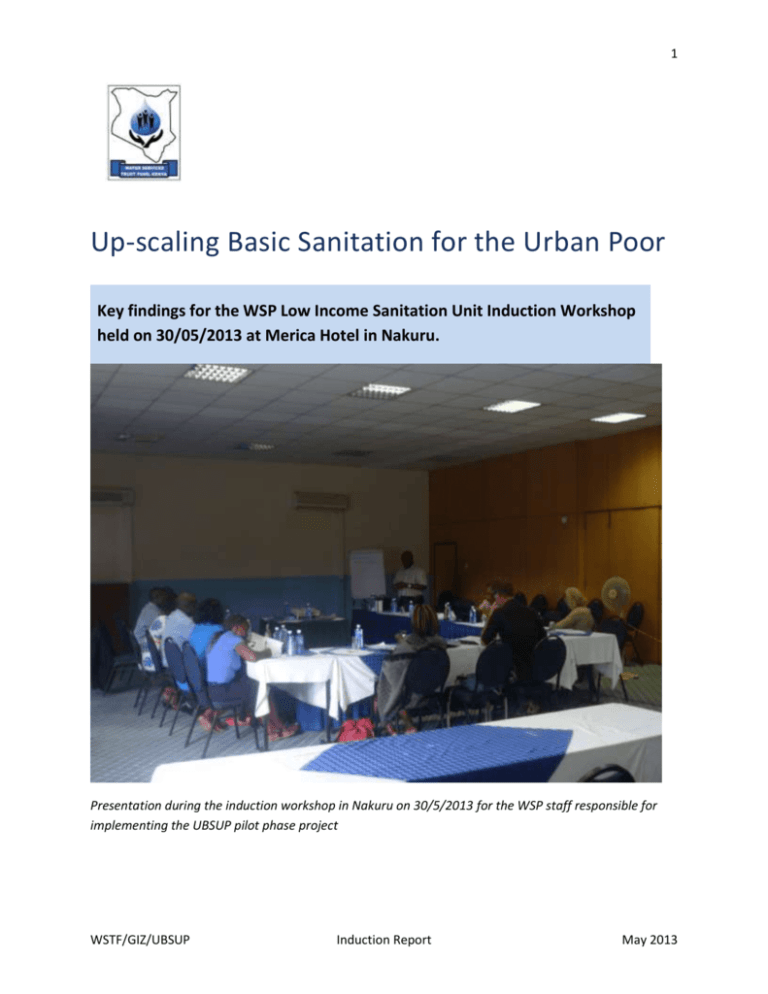
1 Up-scaling Basic Sanitation for the Urban Poor Key findings for the WSP Low Income Sanitation Unit Induction Workshop held on 30/05/2013 at Merica Hotel in Nakuru. Presentation during the induction workshop in Nakuru on 30/5/2013 for the WSP staff responsible for implementing the UBSUP pilot phase project WSTF/GIZ/UBSUP Induction Report May 2013 2 1.0 INTRODUCTION This workshop report contains the following sub topics: General Information List of participants Main Objective of the induction Key findings and arising issues Ministry of Public Health and Sanitation( MPHS) Approach to Sanitation Way forward 2.0 GENERAL INFORMATION Date : 30/02/2013 Venue : Merica Hotel, Nakuru 3.0 LIST OF PARTICIPANTS No Name Institution Role 1 2 3 4 5 6 Eng. John Cheruyot Mr. Kihumba Ms. Akinyi Ms. Zaituni Joyce Kebenei Ms. Vhanice Kwamboka Managing Director Participant/ Technical working group Participant/ Finance working group Participant/ Social Working group Participant/Human resources Facilitator 7 8 9 10 11 12 13 14 Linda Baas Lorine Arodi Eng. Nelson Bosuben Charlotte Nyatichi Cees Lafeber Fidelis Obworo Charles Abdul NAWASCO NAWASCO NAWASCO NAWASCO NAWASCO Ministry of Public Health and Sanitation(MPHS) Vittens WSUP WSTF WSTF WSTF WSTF WSTF Facilitator Logistics Logistics WSTF/GIZ/UBSUP Induction Report Participant Participant Facilitator Facilitator May 2013 3 1. MAIN OBJECTIVEOF THE INDUCTION The main objective of the induction workshop was to give the members of the unit a clear understanding of the Safisan programme (capacity building at the WSP level).This means that at the end of the induction session the participants were able to understand the objectives approach and the outputs expected at the end of the pilot phase of the project. 2. KEY FINDINGS AND ARISING ISSUES. 2.1 2.2 2.3 2.4 2.5 Current facilities in Nakuru County urban setting include Pit latrines Pour Flush Cysten flush Ecosan toilets- However most of them( Approx 99%) are not in use due to disposal challenges and poor design key among other causes. Reference is made to the 32ecosan facilities at Mzee Wanyama LI area bult by an Australian donor) & ROSA project 3. Manual pit emptiers are not allow by the Public Health Act to operate and offer collection and disposal services of sludge . They are secretly hired by landlords and operate illegally at night between(1am -3am) when most people are asleep. 4. The Public Health Act does not allow digging of pit latrines in the urban areas and the cost of digging apit is Ksh 200 for 1m x1m and Ksh 1,000 for 1mx1m in areas with rock formations on average. UBSUP can leverage on this burn of digging pit latrines to promote the UDDTs 5. 5.1 5.2 5.3 Most toilets are build with the following materials Masonary stones Timber Some roofs are built with iron sheets and concrete slub to support water tanks 6. There is ahigh demand for dried treated sludge in Central Kenya for use as manure and atonne of dried sludge cost Ksh.150. 7. Ministry of Public Health and Sanitation approach to Techical & Social Approches Technical Approach 7.1 The Misnisrty of public health and Sanitataion is currently promoting Urban led community total sanitation(UCLTS) to achieve an ODF target by December, 2013 and WSTF/GIZ/UBSUP Induction Report May 2013 4 UBSUP can leverage on this initiative during the pilot and subseqently implementation phase. 7.2 UBSUP developed technical and sludge management option must go through avetting committee comprising of representatives from the Ministry of Public Health and Sanitation, County Council of Nakuru and Town Engineer’s office for necessary approval, before the options are promoted to the target beneficiaries. Aprecedent has been set by among others, Practical Action and Umande Trust who submitted their technical options before the same committee for deliberation and approval. WSTF has to follow the same approach in line with county bylaws. 7.3 The Ministry of Public Health and Sanitation has started atraining programme for Urban community health workers(CHW) starting (3rd-7th)June2013 who will be key in identifying Landlords to be trained on the need for improved sanitation and their obligation by law to do so. This will be followed by mobilising and training of tenants on thier rights to decent and adequate sanitation. UBSUP will leverage on this initiative as well during the the pilot and implementataion phase of the project. 7.4 The County bylaws encourage technical sanitation options with adesign that allows easy connection to sewerline in future. Social Approach 7.5 The Ministry of Public Health and Sanitation(MPHS) have an health committee set to vet messages seeking to promote improved sanitation, hand washing and general hygiene practices. This committee encourages that all messages promoting sanitation be filtered and realigned with those of the MPHS to promote acommon Government policy on sanitation messages. 8.0 The WSP is committed to implemet the pilot phase of the UBSUP project however the Business Model(BM) should be made more clear and simple. Its too complex to understand. 9.0 The WSP management feels that the Ksh 12,500 allocated to Social Animators is little and amarket survey commissioned by the MD shows a wide disparity between market wages and what WSTF is offering. The MD has communicated the matter to CEO WSTF to deliberate and review the proposed payments. 10. There is legitimate fear that the local artisan may not have adequate capacity to render any contractual works before invoicing for subsidies and that the subsidy should be directed to land lords to motivate them to invest in improved sanitation. 11.0 AGREED WAYFORWARD THE TECHNICAL COMPONENT 1. Organise an ugent meeting with representatives of the Munincipal Council of Nakuru, The Ministry of Public Health and Sanitation(MPHS), Town Engineer‘ office, the WSP and WSTF technical team to deliberate on the proposed technical and sludge management options WSTF/GIZ/UBSUP Induction Report May 2013 5 2. 3. 4. 5. 6. 7. and have them approved before they are promoted to target beneficiaries for construction. The WSP feels its the best way foward. To immediately commence aassessment of afew out of the 40 low income urban settlements to identify the viable areas for piloting. Assessment of demand of the technical options based on the areas in terms of soil formation( rocky areas, collapsing soils), proximity to sewerline services among others. Establish the existence of local artisans and if they have been registered by the relevant Govt Ministry of works in the currently on going country wide registration of contractors and artisans. Identification of Decentralized Treatment Facilities sites based on selected areas Lobby the Ministry of Public Health and Sanitation(MHPS) at County level and the Munincipal Council of Nakuru to allow identification ,recruitment, training and registration of Pit manual emptiers tobe able to engage in the collection and disposal of sludge in the most hygienic and environmently safe ways. 11.1 THE SOCIAL COMPONENT 1. To resolve the existing gap in what WSTF is offering to pay Social Animators and current market wages to allow urgent Identification, recruitment and training of Social Animators. 2. Task Team should start planning awareness activities. E.g. radio adverts and barazas. 3. Identify where to build at least four (9) demonstration toilets that can be used by the marketing team to promote the various SafiSan existing technical and sludge management options. 4. To discuss our WSTF developed messages seeking to promote improved sanitation, hand washing and good hygien practices with with the local MPHS official for purposed of ensuring that the same messages are communicated to the target beneficiaries by different partiners on the ground. 5. Astakeholders meeting to be convened to see which partiner is operating where to mitigate overlap and duplication of projects. 6. That WSP and WSTF should send representatives to the on-going training of community health workers(CHW) and subsequent training of landlords and tenants. This training are stagered into groups and segmented. 7. Recruitement of Social Animators should take into account and mainstream gender 8. That community health workers (CHWs) will be more effective in marketing improved sanitation, hand washing and improved hygiene practices and should be considered for recruitment as Social Animators. WSTF/GIZ/UBSUP Induction Report May 2013 6 11.2 BUSINESS AND FINANCIAL MODEL COMPONENT 1. It should be made simple and adoptable 2. Access the viability of the business model and see how the flow of subsidies is carrot for the beneficiaries 3. Assess the affordability of target area beneficiaries because the assumption is that they are poor to afford improved sanitation among other reasons like practice and knowledge but poverty is the the driving force (‘‘read low income household owners and landlords‘‘) 4. The Subsidy to be focal in trigering demand for improved sanitation from target beneficiaries not an impendiment 5. Budget formulation and disbursement of funds to WSPs to commence pilot activities to be given priority. 11.3 MINISTRY OF PUBLIC HEALTH& SANITATIO(MPHS) 1. The MPHS will train community health workers(CHWs) who will map out landlords and tenants for training and sensitisation on the need and obligations for improved sanitation and good hand washing practices in all the 40 Low income urban settlements 2. To mainstream Community Health Workers (CHW) and Community Health Committees (CHC) in all the 100 urban villages in Nakuru to the Social Marketing team. 3. Awareness on Public Health utilizing different promotion forums. 4. Bring NEMA on board for comments and views. 5. Liaise with County/ District development steering committees. 6. Share with the WSP and WSTF currently approved Sanitation options for the county 7. To open discussions to see how the pit emptiers can be brought on board within alegal framework of the County bylaws. NOTE: The Ministry of Public health and sanitation (MPHS) only promotes the soft ware component of Sanitation and that will be the focal area of collaboration with other partners on the ground during and post pilot phase of the SafiSan programme. WSTF/GIZ/UBSUP Induction Report May 2013 7 Above: Cees Lafeber presenting the business and financing model at Merica Hotel on 30/5/2013 during the induction workshop for WSP staff responsible for LIA sanitation unit. Below: Participants during the induction workshop on 30/5/2013 at Merica Hotel in Nakuru WSTF/GIZ/UBSUP Induction Report May 2013
